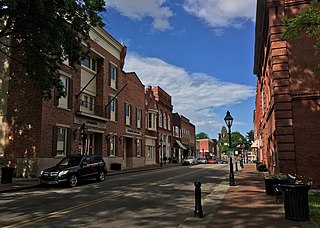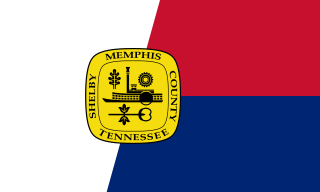
The flag of the state of Oregon is a two-sided flag in navy blue and gold with an optional gold fringe. On the front is the escutcheon from the state seal and on the reverse is a gold figure of a beaver, the state animal. Oregon is the only U.S. State to feature different designs on both sides of its flag.

Hawkins County is a county located in the U.S. state of Tennessee. As of the 2020 census, the population was 56,721. Its county seat is Rogersville, Hawkins County is part of the Metropolitan Statistical Area, which is a component of the Johnson City-Kingsport-Bristol, TN-VA Combined Statistical Area, commonly known as the "Tri-Cities" region.

Rogersville is a town in, and the county seat of, Hawkins County, Tennessee, United States. It was settled in 1775 by the grandparents of Davy Crockett. It is named for its founder, Joseph Rogers. Tennessee's second oldest courthouse, the Hawkins County Courthouse, first newspaper The Knoxville Gazette, and first post office are all located in Rogersville. The Rogersville Historic District is listed on the National Register of Historic Places.

The flag of Colorado was officially adopted to represent the U.S. state of Colorado on June 5, 1911. The flag, designed by Andrew Carlisle Carson, consists of a fess design of three horizontal stripes of equal width, with the top and bottom stripes colored blue, and the middle stripe colored white. A circular red "C", filled with a golden disk, sits atop the stripes. All aspects of the flag contain symbolism related to the state, as the blue is meant to represent the sky, the gold the abundant sunshine the state receives, the white the snowcapped Rocky Mountains, and the red the "ruddy" earth. The gold and white portions of the flag also represent the state's gold and silver mining industries, respectively.

The official flag of Minnesota consists of a dark blue field representing the night sky and the shape of the U.S state of Minnesota, a bright blue field representing the state's abundant waters, and an eight-pointed star representing the North Star using a design prominently featured at the Minnesota State Capitol.

The Seal of the State of Texas was adopted through the 1845 Texas Constitution, and was based on the seal of the Republic of Texas, which dates from January 25, 1839.

The flag of Nashville, Tennessee, consists of the city's seal on a white disc surrounded by a field of blue, with a strip of gold on the fly. According to the resolution adopting the flag, the blue stands for the courage and conviction of the city's leaders throughout history, while the gold denotes the richness of city's land and resources. The flag was adopted in December 1963 when the governments of Nashville and Davidson County merged to form the Metro government. In an official ceremony, it was reigned in as the new flag on August 4, 1964, at the Metropolitan Courthouse. The flag is modeled after the Tennessee state flag.
The Rogersville Review is a twice-weekly newspaper publishing in Rogersville, Tennessee, United States.

Overton Lodge No. 5 is a Freemason lodge under the Grand Lodge of Tennessee. Overton Lodge is located on the Courthouse Square in Rogersville Historic District in downtown Rogersville, Tennessee in the United States.

Joseph Rogers (1764–1833) was an Irish-born pioneer and settler who, with his father-in-law Thomas Amis, founded the town of Rogersville, Tennessee in 1789.

The Hawkins County Courthouse is the seat of county government for Hawkins County, Tennessee, United States, located in the city of Rogersville. It was built in 1836, it is one of six antebellum courthouses still in use in Tennessee, and it is the second oldest courthouse still in use in the state.

The Rogersville Historic District is a historic district in Rogersville, Tennessee, the county seat of Hawkins County. It is both a local historic district and a National Register of Historic Places historic district.

Tennessee marble is a type of crystalline limestone found only in East Tennessee, in the southeastern United States. Long esteemed by architects and builders for its pinkish-gray color and the ease with which it is polished, the stone has been used in the construction of numerous notable buildings and monuments throughout the United States and Canada, including the National Gallery of Art, National Air and Space Museum, and United States Capitol in Washington, D.C., the Minnesota State Capitol, Grand Central Terminal in New York, and Union Station in Toronto. Tennessee marble achieved such popularity in the late-19th century that Knoxville, the stone's primary finishing and distribution center, became known as "The Marble City."
Ken Givens is a Tennessee politician from Rogersville, Tennessee. From 1988-2002, Givens was a member of the Tennessee House of Representatives representing the Ninth State House District. In 2003, he was appointed by Governor Phil Bredesen to be the 34th Commissioner of Agriculture of Tennessee, a Cabinet-level position in the gubernatorial administration responsible for overseeing the Tennessee Department of Agriculture.

Although the Confederate States of America dissolved at the end of the American Civil War (1861–1865), its battle flag continues to be displayed as a symbol. The modern display began during the 1948 United States presidential election when it was used by the Dixiecrats, southern Democrats that opposed civil rights for African Americans. Further display of the flag was a response to the civil rights movement and the passage of federal civil rights laws in the 1950s and 1960s.

The flag of Knoxville, Tennessee, was officially adopted by municipal ordinance on October 16, 1896. It is the third oldest official city flag in the United States and the oldest flag of any state or city governmental entity in Tennessee.

The flag of Chattanooga was adopted 29 August 2012 and is the official flag of the U.S. city of Chattanooga, Tennessee.

The flag of Memphis, Tennessee, was designed by Albert Mallory III, then a student at the Memphis Academy of Arts, and was formally adopted by the city commission in July 1963. The flag was updated in 1967 to its current form, when a new city seal design by Alfred Lewis Aydelott was adopted by the city government, as it transitioned to a mayor-council form of government.

The flag of Cook County, Illinois, nicknamed "I Will", consists of a light blue pall with a green border on a field of white. Six red stars with seven points each sit in a circle at the flag's hoist side, drawing cues from the city flag and other symbols of the county seat of Chicago and its in-county suburbs.

















